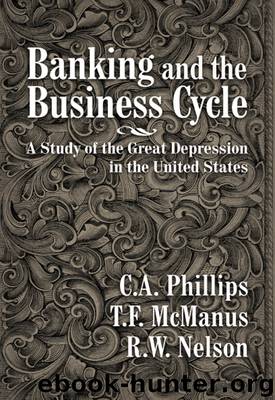Banking and the Business Cycle by C. A. Phillips T. F. McManus & R. W. Nelson

Author:C. A. Phillips, T. F. McManus & R. W. Nelson [C. A. Phillips, T. F. McManus and R. W. Nelson]
Language: eng
Format: epub
ISBN: 978-1-61016-037-7
Publisher: The Macmillan Company
Published: 1937-11-06T16:00:00+00:00
THAT NATURAL RATE OF INTEREST VARIES IS PECULIARLY IMPORTANT
Yet what is sought to be emphasized is the fact that both rates tend to fluctuate. This is of importance in understanding why depression, once under way, persists, for if the natural rate were always a fixity the cycle would become the purely monetary phenomenon that Mr. Hawtrey insists it is and might easily be cured by purely monetary means. All that would be necessary to restore the profitableness of new investment would be to lower the market rate by appropriate bank action, and revival would proceed apace. It is not so simple as this, however, for as D. H. Robertson points out, 1
While there is always some rate of money interest which will check an eager borrower, there may be no rate of money interest in excess of zero which will stimulate an unwilling one. Secondly, * * * the assumption * * * that the total magnitude of the money supply lies entirely within the discretion of the banking-system and not at all within that of the public, seems to have only limited validity for such periods.
The convergence of the two rates of interest destroys the profit prospects which obtained when the market rate was below the natural rate. This leads to a slackening of new investment activity. And when investment ceases to increase at the old rate or actually begins to decline, the disequilibrium between investment and saving which characterized the boom period comes to an end. Investment declines to an equilibrium with saving or, as is usually the case, falls below it.
The decline in investment activity means that the period of positive realized profits is at an end. An alteration in the structure of production the reverse of that which obtains during a boom sets in: the production of producers’ goods declines more rapidly than does the production of consumers’ goods. The unemployment that prevails in the durable goods industries makes its influence felt throughout the whole process of production and over the whole system of interdependent prices. In short, depression is in full progress.2
This is not to imply that all that would be necessary for continued prosperity would be an avoidance of the cessation of the increase of credit—conscious efforts aimed at prolonging the increase in credit might indeed prolong the boom, but by so doing would almost certainly induce increasing maladjustments in production which would prolong the eventual depression, whether initiated by monetary or non-monetary influences.
The point to be emphasized is that it is usually the cessation of the excess flow of credit which brings about the disequilibrium between saving and investment that leads to depression. It is not intended to indicate, however, that there need be an immediate relation between the slowing down of credit increase, the decline in investment activity, and the onset of depression; other influences may be at work, as will be pointed out in Chapter VII, to prolong the boom, for a time, beyond the beginning of the decline in investment activity.
Download
This site does not store any files on its server. We only index and link to content provided by other sites. Please contact the content providers to delete copyright contents if any and email us, we'll remove relevant links or contents immediately.
The Brazilian Economy since the Great Financial Crisis of 20072008 by Philip Arestis Carolina Troncoso Baltar & Daniela Magalhães Prates(117193)
International Integration of the Brazilian Economy by Elias C. Grivoyannis(87007)
The Art of Coaching by Elena Aguilar(52861)
Flexible Working by Dale Gemma;(23237)
How to Stop Living Paycheck to Paycheck by Avery Breyer(19613)
The Acquirer's Multiple: How the Billionaire Contrarians of Deep Value Beat the Market by Tobias Carlisle(12202)
Thinking, Fast and Slow by Kahneman Daniel(12003)
The Radium Girls by Kate Moore(11886)
The Art of Thinking Clearly by Rolf Dobelli(10161)
Hit Refresh by Satya Nadella(9009)
The Compound Effect by Darren Hardy(8751)
Tools of Titans by Timothy Ferriss(8175)
Atomic Habits: Tiny Changes, Remarkable Results by James Clear(8139)
Turbulence by E. J. Noyes(7911)
Change Your Questions, Change Your Life by Marilee Adams(7583)
A Court of Wings and Ruin by Sarah J. Maas(7582)
Nudge - Improving Decisions about Health, Wealth, and Happiness by Thaler Sunstein(7485)
How to Be a Bawse: A Guide to Conquering Life by Lilly Singh(7358)
Win Bigly by Scott Adams(7052)
